
La canne à sucre originelle
Bien qu’il en existe plusieurs variétés, celle qui nous intéresse est la Saccharum Officinarum, décrite par Linné (naturaliste Suédois qui est à la base de la classification actuelle des végétaux, animaux et minéraux) en 1753. Elle doit son nom au fait qu’elle était, dans un premier temps en occident, surtout utilisée dans les préparations en pharmacie.
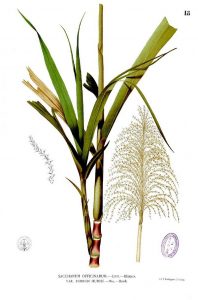
On estime que l’on a commencé à cultiver sa première souche entre 1500 et 1000 ans avant JC. Les Hommes d’alors la consommaient de la façon la plus simple, en mâchant ses tiges pour en extraire le jus sucré.
Elle a commencé à rayonner, d’abord dans les îles voisines d’Indonésie, puis elle s’est propagée dans le reste de l’Océanie et dans le Sud Asiatique jusqu’au Vème siècle avant JC. Durant cette période, elle a été voisine d’autres variétés nées dans l’Himalaya ou dans le Sud de la Chine. Des hybridations avec ces espèces primitives lui ont permis de gagner en taille et en robustesse. C’est là que de « canne de bouche » vivrière, la Saccharum Officinarum est devenue « canne noble », c’est-à-dire propre à la culture sucrière.
C’est au cours du même siècle qu’elle a été connue au Moyen Orient. Les Perses parlaient « d’un roseau qui donne du miel sans le concours des abeilles », et l’ancien testament fait état d’un « doux roseau importé d’un pays lointain ».
L’occident a découvert la canne à sucre grâce à un lieutenant d’Alexandre Le Grand revenant d’une exploration en Inde en -327.
La canne à sucre en Occident
La culture de la canne a continué sa progression vers l’Ouest en s’établissant tout autour de la Méditerranée. C’est une souche d’Inde, héritière des croisements d’espèces originelles, qui a été sélectionnée et propagée. Alors que les Perses avaient domestiqué la canne et même développé la technique permettant d’en extraire le sucre, ce sont les Arabes qui ont commencé à les diffuser. La culture à grande échelle et la fabrication de sucre ont commencé à partir de 637, d’abord dans le croissant fertile de Mésopotamie (qui correspond en gros aujourd’hui à l’Irak, la Syrie, le Liban, Israël et l’Egypte), puis en Afrique du Nord et en Andalousie. C’est ce qu’on appelle « la filière arabe ».
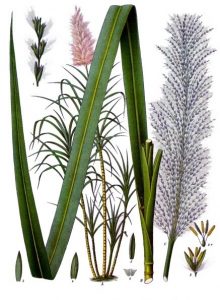
Au cours du XVème siècle, les échanges commerciaux entre les grandes puissances économiques que sont les Génois, les Florentins et les Espagnols vont se retrouver bouleversés par la prise de Constantinople par les Turcs à l’Est et par le recul des Arabes à l’Ouest. Alors que ces derniers reconcentrent avec succès leur production en Afrique du Nord, les Chrétiens consacrent entièrement leurs possessions de Madère, des Açores, des Canaries et de Sao Tomé à la canne et au sucre.
Vers le nouveau monde
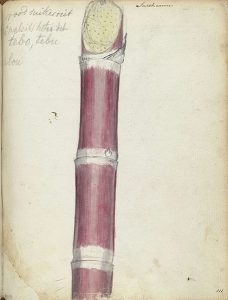
La production du sucre commence en 1509 et s’étend aux Antilles et en Amérique (Porto Rico, Mexique, Brésil, Pérou) au cours du XVIème siècle. C’est au Brésil que naissent les premières grandes plantations sucrières. Très prolifiques, leurs rendements suscitent les convoitises et les attaques d’autres pays colonisateurs. Les Hollandais prennent la place de leader aux Portugais pendant un temps puis se retrouvent chassés du Brésil. Ils se dispersent alors dans les Antilles et appliquent leurs méthodes souvent radicales et brutales. C’est ainsi que les premières expéditions de sucre à partir de Martinique et de Guadeloupe vers le vieux continent commencent au milieu du XVIIème siècle.
Dans le reste du monde
Alors que la culture de la canne à sucre au Moyen Orient, en Méditerranée et en Amérique est intimement liée à une souche venue d’Inde qui sera plus tard baptisée « Canne Créole » ; dans le reste du monde c’est la canne OTahiti (Saccharum Violaceum) qui va changer le paysage.
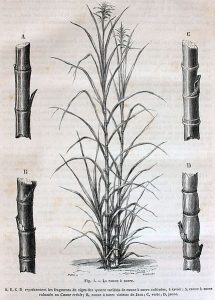
Utilisée lors de recherches et d’essais d’hybridation, elle a tout de même servi à enrichir les gênes de la Saccharum Officinarum d’aujourd’hui qui compte elle-même plusieurs variétés.
Les variétés de canne à sucre
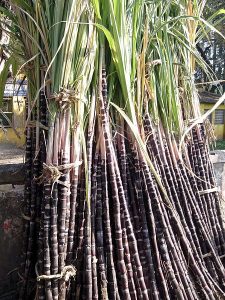
Les variétés ainsi obtenues portent ensuite un nom barbare fait d’une initiale et d’une suite de chiffres. L’initiale correspond à la station d’hybridation, et les chiffres sont une sorte de référence, un numéro de série. Ce n’est qu’au niveau local que la canne adopte un surnom un peu plus charmant. C’est par exemple le cas de la fameuse Canne Bleue bien connue aux Antilles Françaises, et dont le code B.69-566 indique qu’elle a été créée à la Barbade. De la même manière, la Canne Rouge qui porte le code R.579 provient quant-à elle de La Réunion.
Plus encore que la variété de la canne, c’est surtout son terroir qui aura une grande influence. On vous explique pourquoi dans cet article sur l’importance de la canne et du terroir.
De l’âge d’or des plantations à la canne à sucre d’aujourd’hui
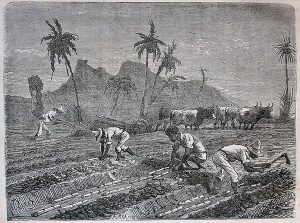
Pour savoir comment la canne à sucre devient rhum, nous vous avons aussi préparé un article sur l’élaboration du rhum et les différents styles de rhum. Bonne lecture !
quel est le premier pays a produirre du rhum et en quelle année
Bonjour, c’est une question à laquelle il n’est pas facile de répondre, car les écrits manquent en ce qui concerne les toutes premières distillations de canne à sucre. On estime toutefois qu’elles remontent au début du XVIème siècle, à Madère puis au Brésil. Les premières mentions officielles de rhum “moderne” au sens où on l’entend aujourd’hui, remontent à 1688 et 1702 à La Barbade.
Le Brésil où elle a été introduite en premier en 1504 et qui est le premier producteur de sucre